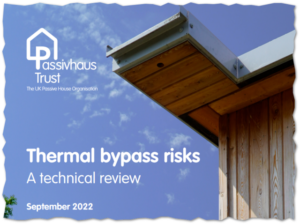The Thrive 2024 Passivhaus Conference in Melbourne last week was great—here are my highlights. It was well worth nipping across the ditch for two days. (Was I really the only person from New Zealand in attendance?) I estimate there were about 320 people there, plus those at the trade show, a big turnout. Here were the top three sessions for …
Earthbuilding Standards x3 out for consultation

Three revised New Zealand Earthbuilding Standards are out for public comment. This is a great opportunity—very time limited—to review the content of the draft standards without having to purchase them. These are only available until 26 May 2024. Download the files here. There is general background on the Earth Building Association of New Zealand (EBANZ)’s website, available here. These standards …
Three steps to mitigate condensation risk in wall assemblies

Significant changes are proposed to minimum Code requirements for commercial buildings in Australia and I’ve been particularly interested in measures to mitigate condensation risk in walls. It’s important New Zealand Passive House designers and architects focus on those measures aimed at the parts of Australia with heating-dominated climates similar to ours. The report findings are worth reading, but here’s a …
Developers need a way to participate in the carbon market

We work with motivated clients focused on reducing the carbon emissions associated with their construction projects. In general, I’d characterise their (our) main reason for doing this as the belief that it’s the right thing to do. Also that it’s essential that design professionals (and builders) develop their understanding of how to minimise operational carbon emissions. It’s a slightly odd …
Four very good reasons to sign up for designPH Skills right now

You’ll hear me talking a lot about designPH over the next couple of months. That’s because it’s a seriously useful tool that, once mastered, delivers staggering efficiencies and improvements in energy modelling for high-performance and Passive House buildings. Applications are open for a live, online course led by me, Jason Quinn, that starts on 4 June 2024—soon! Detailed course info …
Thermal bypass a basic step to improving building performance

I get asked periodically how to increase building performance without spending extra money. Well, better-than-Code performance is going to cost something so I focus on low-hanging fruit: what’s the greatest benefit for the least cost? Let’s assume continuous mechanical ventilation is already included, because that’s the single most important thing. After that, I recommend preventing thermal bypass via a dedicated …
Keep heat pump and ventilation systems separate for best results

Buildings need fresh air, every single one of them. Even the very best-performing ones will also need some (possibly very little) heating or cooling at peak times of year. Ducting costs money and some people are tempted to combine heating/cooling systems with ventilation. Don’t do this, is my advice. Best practice is a fully decoupled system design for ventilation (dedicated …
SketchUp’s new release does not work with designPH 2.1
SketchUp 2024 is now available but if you are using designPH, please hold off on updating SketchUp until designPH2.2 is released! Otherwise you won’t be able to use designPH. PHI has been working on this but SketchUp didn’t tell them it was releasing 2024 until it had already happened. PHI’s testing of designPH v2.1.15a found that the change to Ruby …
Is Passive House actually worth it?
I’m often asked (usually politely): Is building to the Passive House standard actually worth it? Yes it is, is the unequivocal answer. There’s a brilliant summary paper written by Dr Ürge-Vorsatz and others that is my go-to evidence when I am persuading sceptics. The bottom line is that with current technology, we can build nearly zero-energy buildings almost anywhere at …
